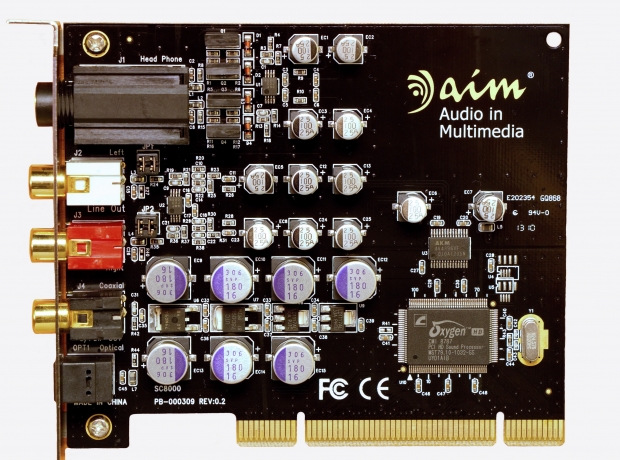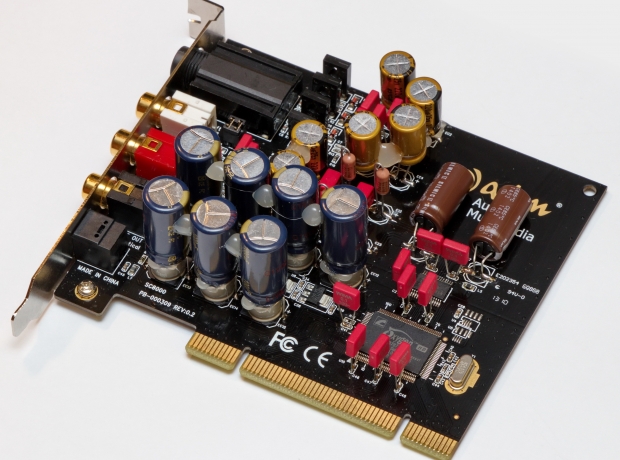Spis treści
AIM SC8000 is a PC sound card that deviates a little from the adopted trend. It’s a solid and cheap sound card, that lets you enjoy decent stereo sound with a powerful headphone amplifier on board.
It’s an offer addressed to people, who want to get a good source of power for their headphones at a low cost. To meet market requirements, the sound card software allows to simulate surround sound and handle additional effects. Personally, I haven’t tested these additives, because I assume that the artificial pumping of sound has to much effect of quality deterioration and simply introduces unnecessary deformations.
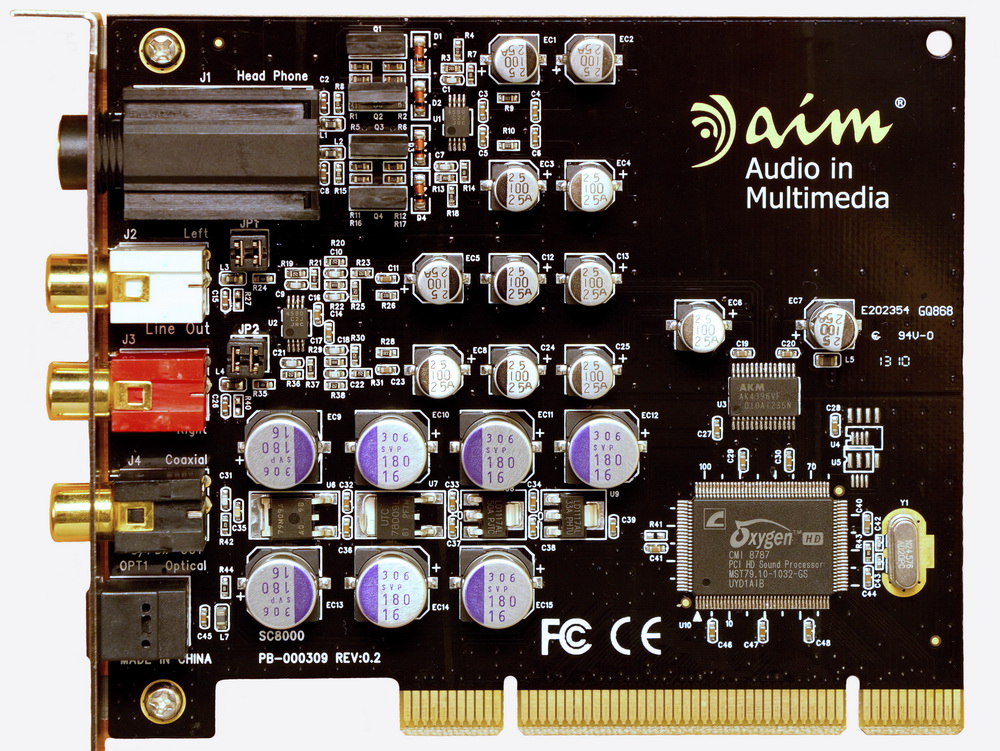
Modification of AIM SC8000 turned out to be an interesting challenge. I used two computer sets to test changes introduced by subsequent stages of modification. One computer had a cheap and not very efficient power supply, while the other had a branded power supply with proven parameters OCZ ModXStream Pro. I was very surprised by the differences in the sound of the sound card, depending on what power supply was powering it, and I described the details below. Another variation of the tests was the use of two different headphones, Audio-Technica ATH-TAD400 and Sennheiser HD 598. After a more detailed analysis of the design of the sound card, I noticed that I can improve a lot in it. It also turned out that the manufacturer applied a not very good solution that severely limited the card’s capabilities. I invite you to read and adventure with modification AIM SC8000.
Construction of the AIM SC8000
AIM SC8000 is a simple construction. The C-Media CM8787 sound processor is responsible for communication with the computer, and then provides a digital audio signal to the AKM AK4396 digital-to-analogue converter. The analog signal from the D/A converter is assembled in its entirety by the NJM4580 operational amplifier and forwarded to the analog RCA output, or to the headphone amplifier. The remaining elements on the circuit board are responsible for the stable power supply of all mentioned components.
How does it all sounds? Really decent, I recommend a review on audiofanatyk.pl website. I can add from myself, that for it’s price, the card provides a huge quality jump in the matter of headphones powering, in relation to what integrated PC sound cards can offer. SC8000 does not impress or mark out itself with any great sound qualities, but it should be emphasized, that at the same time it does not deforms significally anything in transmission. The sound card plays correctly and not very engaging. The whole sound transmission is quite closed, and the sound stage not very large. Locating of the virtual sources requires some effort from the listener, however, it should be remembered that in the price, that you have to pay for this device, the sound qualities deserve of big praise.
Improvement of the signal path and low-pass filter
The description of the first introduced change I begin with a fairly strong accent of dissatisfaction. I keep repeating to myself that I am dealing with a budget card for little money and I should not require too much, but what I will describe below evokes a lot of emotions. I understand that in the case of such constructions, manufacturer saves on everything, but when we are dealing with a solution that could be omitted and additionally uses elements that are completely out of place and of poor quality, this solution can be compared only to shot in the knee before the spectacular run.
In the signal path between the D/A converter AK4396 and the operational amplifier, coupling capacitors were used. I understand the idea of this solution and I can accept it. I do not understand why it was decided to use low-quality electrolytic capacitors and, what is worse, with a specific polarization. These are the same capacitors, which are also used to supply operational amplifiers and D/A converter, so it was probably cheaper to buy more of the same capacitors and mount them also in the signal path. Substantially, the capacitors fulfill their function as a low-pass filter and limit the range of higher frequencies, however, the implementation of the filter, through using the defect of the element is not good solution and reflects on the sound quality. Probably it would be more wise to save money on the D/A converter and allocate more funds for a better low-pass filter, because this would have a better effect, but here the marketing comes to voice and the question of what symbol of the D/A converter appears on the box. The implemented solution is a very serious error, which in addition greatly affects the sound quality.
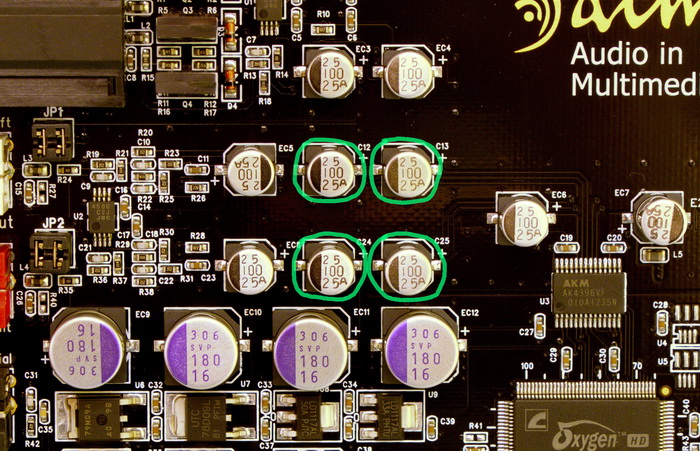
I decided to remove the capacitors from the signal path and replace them with jumpers. The effect was predictable, and yet amazing. The sound card gained a much livelier transmission and greater openness. The stage has grown very wide, the depth has increased slightly, but noticeably. The issue of dynamics is a leap into a completely different world, compared to what the removed capacitors offered, it is a real dynamite. The removal of capacitors also has its disadvantage, which consists in highlighting the middle and high range and their sharpening, this is a natural consequence of the removal of the low-pass filter. However, the whole transmission is so engaging that this change in the tonal balance does not bother so much. However, I could not leave this issue at this way and I decided that in the place where electrolytic capacitors were installed, I could build a low-pass filter, which should improve the quality of the higher ranges and slightly lower their level. I used WIMA FKP2 1nF capacitors and Vishay DALE 1k ohm resistors to build the filter. Such parameters provide a filter with a cut-off frequency of 160kHz.

Changes introduced by the new filter were big and very positive. The upper registers have become smoother and more transparent. Although they still left much to be desired on the HD 598 headphones. Interestingly, I noticed the increase in the depth dimension. The tonal balance has improved slightly, it is still shifted up, but this shift is not so significant anymore and adds even an interesting accent to the entire transmission. The tonal balance could be further improved by changing the filter parameters and shifting the cut-off frequency to 115-130kHz (change of resistor to 1.2k – 1.4k ohms), however I decided to stay at 1k ohm, because I knew that further modifications will certainly improve tonal balance and the quality of higher registers.
Power supply modification
The sound card contains four voltage regulators generating 3.3V, 5V, +-9V voltage. 3.3V voltage is used to power the CM8787 sound processor and the digital section of the AK4396 D/A converter. The 5V voltage is needed to power the analog section of the AK4396 converter. The rest of power voltages (+-9V) is used to power operational amplifiers and headphone amplifier. I decided that the factory electrolytic capacitors for the integrated circuits will be changed on Nichicon Fine Gold capacitors, I had a feeling that their analytical character will fit well with the AIM SC8000 sound card.
Capacitors of operational amplifiers
There are two operational amplifiers on the sound card. The first op-amp placed near the RCA sockets is responsible for receiving and processing the signal from the D/A converter. The power quality of the op-amp is ensured by two electrolytic capacitors and four SMD decoupling capacitors. I decided, that the decoupling capacitors near the op-amp would be replaced at WIMA MKS2 0.1uF, and the other two located closer to the electrolytic capacitors would be left unchanged due to the small amount of space. I thought that in the case of electrolytic capacitors, it might be a good idea to increase the capacitance and use 220uF capacitors instead of 100uF factory capacitors. Usually, the 100uF capacity is quite sufficient for the operational amplifier, but in this case the power lines are also loaded with the headphone amplifier, which is why I decided to increase the capacity of the capacitors.
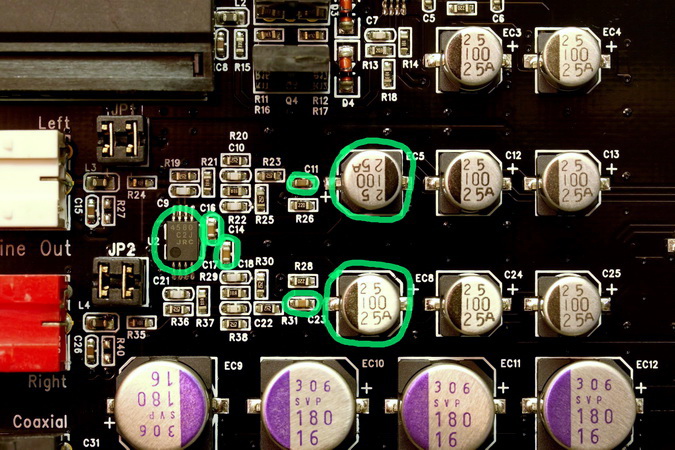
The second op-amp is located on the top of the sound card and forms a buffer between the first op-amp and the headphone amplifier. The electrolytic capacitors located at this op-amp are responsible for the power supply quality of the operational amplifier and transistors of the headphone amplifier, therefore the manufacturer decided to use as many as four electrolytic capacitors and an SMD decoupling capacitor at each of them. In this case I also thought that increasing the capacity to 220uF might be a good idea. The arrangement of the elements allowed to replace all decoupling capacitors on WIMA MKS2 0,1uF.
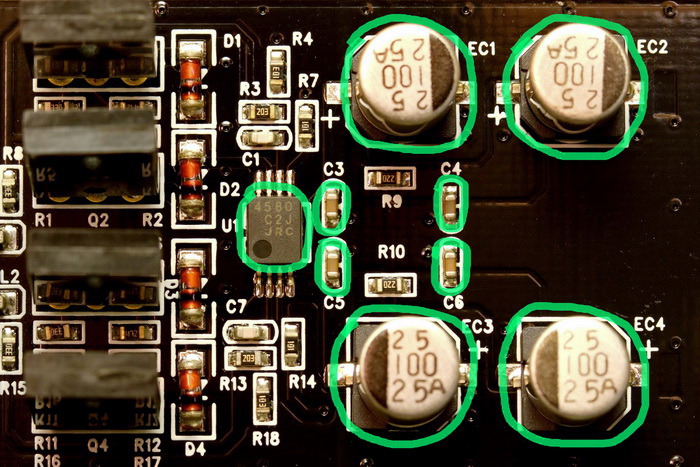
Increasing the capacitors capacity turned out to be a good idea. The first listenings showed that this procedure was especially needed for the headphone amplifier. The amplifier started to play with much more energy. Dynamics has grown clearly. Thanks to the character of Nichicon Fine Gold capacitors, the sound has become more analytical and gained more space. The bass is fast, energetic, plastic and does not lose control even when listening louder, which caused problems before. I am not a bigest fan of the analytics character of Nichicon FG capacitors, but in combination with the AIM SC8000 sound card they give a very pleasant and interesting effect. I think Nichicon FG is the best choice for this sound card. The middle and upper registers have also gained a lot. It was difficult to accuse these registers of serious defects before modification, because they were well masked by the closed and withdrawn transmission. After the changes, they opened up more and became clearer.
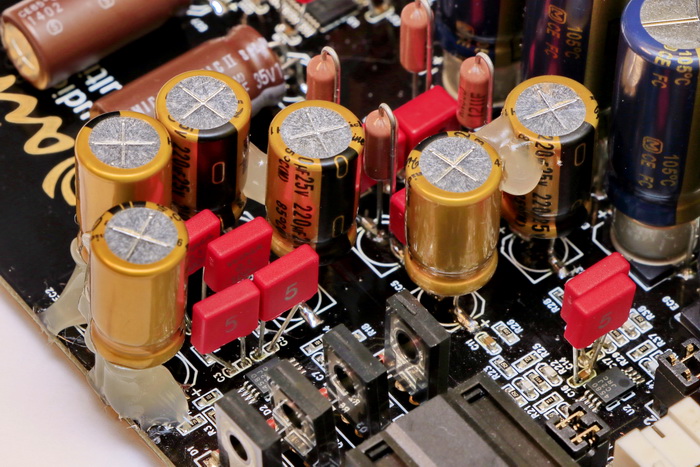
Only after replacing capacitors at operational amplifiers, positively surprised by the obtained effect, I decided to check the sound card on another computer. It was not about the issue of another power supply, but the possibility of comparing the introduced changes with my DAC ASUS XONAR STU. It turned out, however, that connecting the sound card in another computer changed its sound very much. The computer power supply was certainly better (OCZ ModXStream Pro), because the quality of higher registers improved and more space appeared, but at the same time the dynamics decreased, the lower registers lost their speed and energy. Despite positive changes for higher registers, the Sennheiser HD 598 headphones still revealed significant shortcomings of these ranges, but the listenings showed, that I was going in the right direction and I chose right values for capacitors at operational amplifiers. At the same time, in this case, I found out how large discrepancies in high-frequency reproduction are betwen the Sennheiser HD 598 and Audio-Technica ATH-TAD400 headphones, because only HD 598 showed that the upper range still needs improvement, and for ATH-TAD400 was already acceptable.
Capacitors of the AKM AK4396 D/A converter
Near the D/A converter there are two 100uF electrolytic capacitors and tree SMD decoupling capacitors. Capacitors at the D/A converter have been replaced at the same time as capacitors at operational amplifiers onto Nichicon Fine Gold with a capacity of 100uF and decoupling capacitors on WIMA MKS2 0.1uF. Therefore, the listening experience described in the section with the replacement of capacitors at operational amplifiers also applies to changes introduced by the capacitors at the AKM AK4396 converter. I decided to separately describe the capacitors for the D/A converter, because there was a change in the final version.

I was wondering how to deal with the problem of tonal balance and decided to check whether the change of Nichicon FG capacitors on ELNA SILMIC II at the D/A converter will not have a positive effect on lowering the level of higher registers. Replacing the capacitors proved to be a very good idea. The D/A converter fits perfectly with the ELNA SILMIC II capacitors. The tendency to emphasize the higher ranges is still audible, but only after the introduction of ELNA capacitors can it be considered more in the category of character than the defect.
I must admit that fighting the AIM SC8000 tonal balance was not easy and required all the changes described above to be achieved in order to obtain a satisfying effect. Looking from this perspective, one can justify the manufacturer a bit, that instead of fighting this issue, he simply installed dark and inexpensive capacitors in the audio track, that effectively masked the problem. Going further this path, we can conclude, that since these capacitors worked so well when stopping the higher frequencies in the audio track, they also so well do not short-circuit high frequency distortions to mass (they do not filter) when used in power supply circuit, which means that their filtering ability and cleaning up the power supply from distortions is not very good, and what has not been filtered out goes to the op amps and the D/A converter.

Electrolytic capacitors of power supply
At this point, the manufacturer should be praised. In case of power regulators, very good capacitors Sanyo SVP have been used, which are characterized by low ESR. Certainly, they have a significant impact on the ratings that the sound card receives in tests. There is a total of seven capacitors . The three at the bottom are the input capacitors in front of the power regulators. The four at the top take care of the condition of the output voltages from the power regulators, whitch supply the card’s subassemblies. Capacitors have a small capacity as for their application 180uF, but apparently the manufacturer decided that such a capacity combined with a low series resistance is enough to provide good quality power.
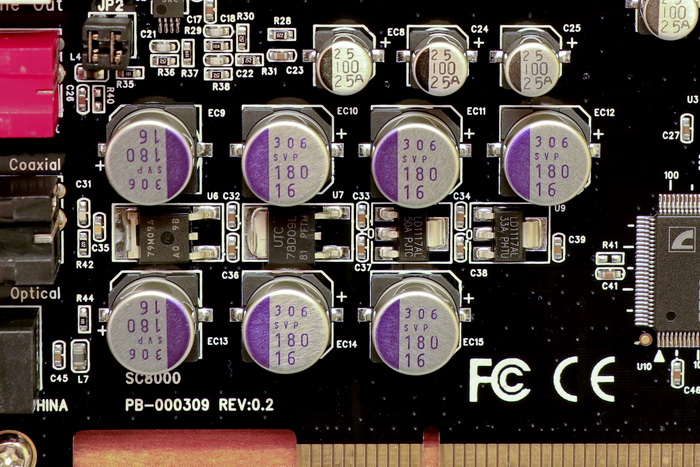
At the beginning, while assessing what should I change in the sound card, I felt that interference in this part of the power supply section does not make much sense. The capacitors at the operational amplifiers and the AKM AK4396 converter left a lot to be desired, but the capacitors at the power regulators I considered well chosen.I changed my mind when I connected the sound card to another computer with a much better power supply. This happened before I finally chose the value for the LPF filter and the ELNA capacitors for the D/A converter, so the sound served by the sound card still had many shortcomings and the differences due to the change of the power supply were all the more audible. On one power supply I got a very analytical and dynamic sound, which despite its flaws and problems with tonal balance, was very interesting and engaging. The second and better power supply improved the tonal balance and calmed down a bit sharp top registers, but at the same time it took away a lot of dynamics and made the lower registers lose their contours and blend together. Interestingly, this dynamic and sharp sound from an inferior power supply, appealed to me more and made me feel closer to the correct sound than a calmer sound from a better power supply, although in the end I was unable to accept any of presented sounds.
From the conducted listenings, I concluded that the sound card is very sensitive to changes in power supply quality. I decided to check if the addition of more capacity to the capacitors of power regulators, would have a positive effect and would make the sound card less sensitive to changes in the power supply quality. I decided to leave the Sanyo SVP capacitors in place and added to them the Panasonic FC 1000uF 35V capacitors. The information in the catalog sheet shows, that the used Sanyo SVP have the same series resistance (0.03 ohma) as the Panasonic FC 1000uF 35V, so this connection should give a very good capacitor bank with a capacity of almost 1200uF and a 0.015 ohma series resistance, and this there are already very good parameters.

The obtained effect is very good. The additional capacity of the capacitors on the power supply was very much needed. Discrepancies in sound caused by different computer power supply have been clearly reduced. In both cases, the quality of high tones and to a significant extent the tonal balance improved. The midrange registers were still a bit before the row, which was later corrected by the exchange of capacitors at the D/A converter for the ELNA SILMIC II, but the advance of the midrange registers forward was already at an acceptable level. The most interesting changes took place at the bottom of the band. For the better power supply, the dynamics of the bottom have grown significantly and contours appeared, and with them more space. As in the case of a worse power supply, the dynamics is now above average and gives a very interesting and engaging effect. However, for the worse power supply the dynamics have decreased a little, but slightly and still gives a lot of listening pleasure.
The difference in the sound of the card when you change the power supply can still be heard, but they are so small that they do not change the sound so radically. The addition of Panasonic FC capacitors has one drawback, which is the change in the height of the sound card, which now occupies the height of 2 PCI slots, which for some may cause a problem with the place in the computer chassis. Can use lower capacitors with lower voltage and lower capacity, but I personally advise the capacitance in the 1000uF area, because I have not tested other capacities and I can not predict how they can affect the sound. It is certain, that in order for the entire modification of the device to make sense, it is necessary to increase the capacity of the power supply capacitors, so that the sound card is less sensitive to the quality of the computer power supply. As my listenings showed, a better power supply does not mean that we will get a better final result. On the other hand, increasing the capacity of the capacitors in each case had a positive effect, which unified the sound of the sound card.
Decoupling capacitors of the C-Media CM8787 sound processor
This is the place where space is born. So far, all the modifications that I introduced, were made in the analog domain. Digital audio signal transmission is quite a controversial issue and more than once I had the opportunity to participate in a discussion during which more than one skeptic let go of emotions. In the end, what to talk about here, digital transmission works and you can distinguish between two states (0 and 1) or not and the transmission does not work. The issue of digital transmission, however, is not so simple, which I have experienced more than once, hearing things that I should not hear, but this is a topic for another and not small feuilleton.
So far, I managed to achieve a lot and significantly change the visage of the SC8000, but I was not satisfied with the quality of the sound stage. The stage was quite wide, but it had little depth. There was a lack of space between virtual sources and the so-called black background. For this state of affairs I suspected operational amplifiers, in the end they are budget constructions and certainly have their drawbacks, maybe one of them is the average reproduction of the stage? Based on previous experience in the differences in the sound when the power supply is changed and in accordance with the principle “what is lost can not be recovered” I decided to check whether at the very entrance to the sound card, the C-Media CM8787 processor does not degrade sound. There are several decoupling capacitors in the neighborhood of the processor and I decided to improve their efficiency by adding WIMA MKS2 capacitors.
The changes were really surprising and more importantly large and clear. They can be compared to switching from a impulse to a stabilized power supply in DAC. The most important issue is the depth of the stage, which finally matched the size of the width. Along with the depth, much more space appeared between the sources. In addition, the quality of high registers has improved, which even with the Sennheiser HD 598 headphones began to sound really mature and pleasurable. Interesting changes have also occurred at the lower registers. Bass became more elastic and weighted. The position and sound of the instruments finally began to remind to what I’m used to.
I must admit that I am surprised by the introduced changes. I did not expect so much lost of the signal quality in the sound processor itself that works in the digital domain. This example, once again showed me and confirmed my opinion that digital audio transmission has its advantages and disadvantages. It is more resistant to interference, but it does not mean that it is completely resistant, and certainly not resistant enough, that you can not hear interferences. It is amazing how much I managed to change thanks to 6 decoupling capacitors.
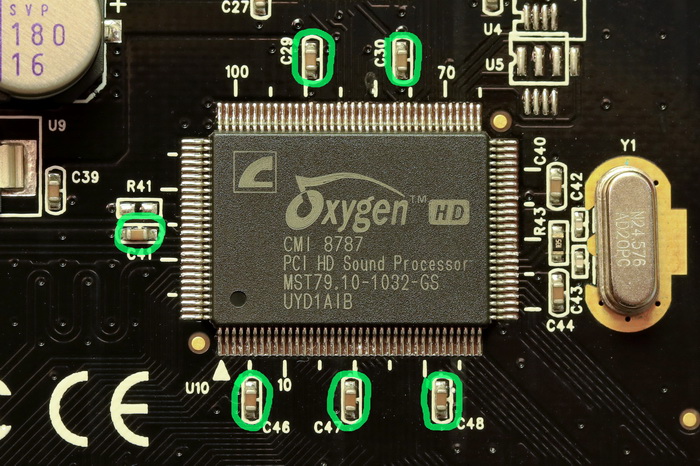

Summary
Modification of AIM SC8000 turned out to be an interesting challenge. Interesting in terms of changes carried out by subsequent stages of modification. The modifications of the devices that I have carried out so far were quite simple, because each subsequent change brought improvement without a major compromise. The SC8000 modification proved to be a bigger challenge, because each of the changes apart, from clear benefits, also introduced some drawbacks, which ultimately could not be accepted by me. However, proper link and fine-tuning of individual stages of modification as a last resort gave a very good effect.
The sound card has changed its face a lot. There are still some shortcomings and the high tones could be better, although the level they present now is an abyss compared to what they presented with the factory-set card. The stage could also be bigger, after a longer listening experience a limited space between the virtual sources is audible, but also in this case the differences in relation to the factory sound card are very large. On praise deserves vocals, that are simply outstanding, taking into account the class of the device and if the stage is not to much crowded, they can absorb the listener. The lower registers gained a lot of dynamics and space, which was largely due to the modification at the CM8787 processor. It should be emphasized, that I didn’t replaced operational amplifiers. I decided to leave the NJM4580 op amps, because I did not find a better alternative for them in the SSOP-8 enclosure. NJM4580 are budget op amps in the price of 1 USD per piece and their exchange would certainly affect the next quality step. It is a pity that the manufacturer has not decided on a larger housing for operational amplifiers, such as SO-8, because in this housing there are many good constructions that would certainly introduce significant and positive changes.
Modification of the AIM SC8000 even without replacing the operational amplifiers is a very good investment and changes the sound card into a completely different device. In my opinion, the sound card presents after modification the sound, which can compete with constructions at least 2-3 times more expensive. It is a sound that for many people can be a target sound and provide a decent power supply for the class of headphones like Sennheiser HD 598. After over a week of listening, I find that Audio-Technica ATH-TAD400 headphones are not enough any more for the SC8000 card after modification.
Below are photos before and after modification.



